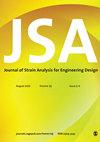重访增材制造金属管的环箍试验
IF 1.8
4区 工程技术
Q3 ENGINEERING, MECHANICAL
Journal of Strain Analysis for Engineering Design
Pub Date : 2021-09-04
DOI:10.1177/03093247211045236
引用次数: 3
摘要
本文主要研究了电弧增材制造(WAAM) AISI 316-L不锈钢管的力学性能和成形性能。所提出的方法包括对从管道纵向、横向和倾斜方向提取的样本进行张力和环箍张力试验。从测压元件获得的力演变和应变测量,从数字图像相关和沿裂纹的厚度测量中检索,允许获得应力-应变曲线,应变路径和三个不同管方向的断裂破坏开始。特别注意的是环箍试验,它被重新审视,以确定使用一个或两个哑铃几何形状的环试件的适当性。在具有强各向异性行为的WAAM管中使用环箍拉伸试验的独创性允许获得从平面应变到纯剪切变形条件的应变加载路径。在演示期间,采用商用AISI 316-L不锈钢管作为参考。本文章由计算机程序翻译,如有差异,请以英文原文为准。
Revisiting the ring hoop test in additively manufactured metal tubes
This paper is focussed on the mechanical and formability characterisation of wire-arc additive manufactured (WAAM) AISI 316-L stainless-steel tubes. The methodology to be presented involved carrying out tension and ring hoop tension tests on specimens extracted from the tube longitudinal, transverse and inclined directions. The force evolutions, acquired from the load cells, and the strain measurements, retrieved from digital image correlation and from thickness measurements along the cracks, allowed obtaining the stress-strain curves, the strain paths and the onset of failure by fracture for the three different tube directions. Special attention was paid to the ring hoop test, which was revisited to determine the appropriateness of using ring specimens with one or two dumbbell geometries. The originality of using the ring hoop tension test in WAAM tubes with strong anisotropic behaviour allowed obtaining strain loading paths that range from plane strain to pure shear deformation conditions. Resort to commercial AISI 316-L stainless-steel tubes during the presentation is included for reference purposes.
求助全文
通过发布文献求助,成功后即可免费获取论文全文。
去求助
来源期刊

Journal of Strain Analysis for Engineering Design
工程技术-材料科学:表征与测试
CiteScore
3.50
自引率
6.20%
发文量
25
审稿时长
>12 weeks
期刊介绍:
The Journal of Strain Analysis for Engineering Design provides a forum for work relating to the measurement and analysis of strain that is appropriate to engineering design and practice.
"Since launching in 1965, The Journal of Strain Analysis has been a collegiate effort, dedicated to providing exemplary service to our authors. We welcome contributions related to analytical, experimental, and numerical techniques for the analysis and/or measurement of stress and/or strain, or studies of relevant material properties and failure modes. Our international Editorial Board contains experts in all of these fields and is keen to encourage papers on novel techniques and innovative applications." Professor Eann Patterson - University of Liverpool, UK
This journal is a member of the Committee on Publication Ethics (COPE).
 求助内容:
求助内容: 应助结果提醒方式:
应助结果提醒方式:


